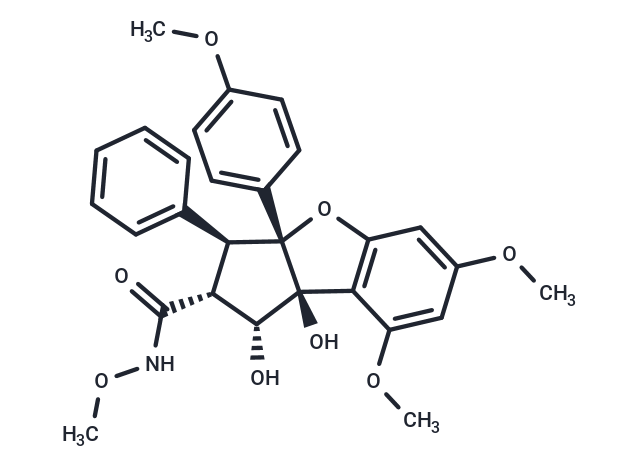 您的购物车当前为空
您的购物车当前为空
CR-1-31-B
一键复制产品信息CR-1-31-B, a synthetic rocaglate, acts as a highly potent inhibitor of eIF4A. By disrupting the interaction between eIF4A and RNA, it effectively obstructs the initiation phase of protein synthesis. Specifically, CR-1-31-B interferes with the association between Plasmodium falciparum eIF4A (PfeIF4A) and RNA. Additionally, CR-1-31-B induces apoptosis in neuroblastoma and gallbladder cancer cells [4].

CR-1-31-B
一键复制产品信息CR-1-31-B, a synthetic rocaglate, acts as a highly potent inhibitor of eIF4A. By disrupting the interaction between eIF4A and RNA, it effectively obstructs the initiation phase of protein synthesis. Specifically, CR-1-31-B interferes with the association between Plasmodium falciparum eIF4A (PfeIF4A) and RNA. Additionally, CR-1-31-B induces apoptosis in neuroblastoma and gallbladder cancer cells [4].
| 规格 | 价格 | 库存 | 数量 |
|---|---|---|---|
| 5 mg | ¥ 9,090 | 8-10周 | |
| 10 mg | ¥ 12,900 | 8-10周 | |
| 25 mg | ¥ 25,800 | 8-10周 |
产品介绍
| 产品描述 | CR-1-31-B, a synthetic rocaglate, acts as a highly potent inhibitor of eIF4A. By disrupting the interaction between eIF4A and RNA, it effectively obstructs the initiation phase of protein synthesis. Specifically, CR-1-31-B interferes with the association between Plasmodium falciparum eIF4A (PfeIF4A) and RNA. Additionally, CR-1-31-B induces apoptosis in neuroblastoma and gallbladder cancer cells [4]. |
| 体外活性 | CR-1-31-B (100 nM; 24 hours) inhibits MUC1-C translation in MCF-10A cells (EGF-stimulated)[1]. CR-1-31-B (10 and 100 nM) decreases MUC1-C abundance in MDA-MB-468 breast cancer cells[1]. CR-1-31B sensitizes gallbladder cancer cells to TRAIL-mediated apoptosis through the translational downregulation of c-FLIP[2]. Neuroblastoma (NB) cell lines exhibit decreased viability, increased apoptosis rates as well as changes in cell cycle distribution when treated with the synthetic rocaglate CR-1-31-B (24-72 hours), which clamps eIF4A and eIF4F onto mRNA, resulting in a translational block[4]. CR-1-31-B (100 nM; 5 hours) treatment increases reverse glutamine metabolism in pancreatic cancer cells[5]. Western Blot Analysis[1]Cell Line: MCF-10A cells (EGF-stimulated) Concentration: 100 nM Incubation Time: 24 hours Result: Blocked increases in MUC1-C abundance. Cell Viability Assay[4]Cell Line: SH-SY5Y cells and Kelly cells Concentration: 0.1-100 nM Incubation Time: 24-72 hours Result: A significant decrease in SH-SY5Y viability was observed at 10 nM for all time points. Significantly decreased the viability of Kelly cells at 5 nM. The calculated IC 50 at 48 h was 20 nM for SH-SY5Y and 4 nM for Kelly cells. Apoptosis Analysis[4]Cell Line: SH-SY5Y and Kelly cells Concentration: SH-SY5Y cells were treated with 10, 20, and 50 nM and Kelly cells with 1, 5, and 10 nM Incubation Time: 24-72 hours Result: Triggered apoptosis. |
| 体内活性 | CR-1-31-B (2 mg/kg in 60 μL olive oil; IP; once every 2 days for 28 days) reduces the growth and initiates TRAIL-induced apoptosis in a BALB/c nude mice model of gallbladder cancer cells (GBC)[2]. CR-1-31-B (0.2?mg/kg; IP; daily for 7 days; murine orthotopic transplant model of pancreatic ductal adenocarcinoma) effectively inhibits protein synthesis and growth of pancreatic tumours[5]. |
| 分子量 | 507.539 |
| 分子式 | C28H29NO8 |
| CAS No. | 1352914-52-3 |
| 密度 | 1.356 g/cm3 (Predicted) |
| 存储 | Powder: -20°C for 3 years | In solvent: -80°C for 1 year | Shipping with blue ice/Shipping at ambient temperature. |
计算器
体内实验配液计算器
以上为“体内实验配液计算器”的使用方法举例,并不是具体某个化合物的推荐配制方式,请根据您的实验动物和给药方式选择适当的溶解方案。
剂量转换
对于不同动物的给药剂量换算,您也可以参考 更多





 还可以
还可以
 |
|